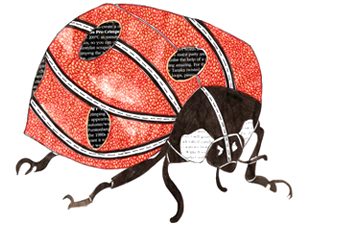Coccinella septempunctata, the seven-spot ladybird (or, in North America, seven-spotted ladybug or “C-7”[1]), is the most common ladybird in Europe. Its elytra are of a red colour, but punctuated with three black spots each, with one further spot being spread over the junction of the two, making a total of seven spots, from which the species derives both its common and scientific names (from the Latin septem = “seven” and punctata = “spotted”).
C. septempunctata has a broad ecological range, living almost anywhere there are aphids for it to eat. Both the adults and the larvae are voracious predators of aphids, and because of this, C. septempunctata has been repeatedly introduced to North America as a biological control agent to reduce aphid numbers, and is now established in North America, and has been subsequently designated the official State insect of six different states (Delaware, Massachusetts, New Hampshire, Ohio, Pennsylvania, and Tennessee).
In the United Kingdom, there are fears that the seven-spot ladybird is being out-competed for food by the harlequin ladybird.[2] Conversely, in North America, this species has outcompeted many native species, including other Coccinella.
An adult seven-spot ladybird may reach a body length between 0.76 and 1.0 cm (7.6 and 10 mm). Their distinctive spots and attractive colors are meant to make them unappealing to predators. The species can secrete a fluid from joints in their legs which gives them a foul taste. A threatened ladybug may both play dead and secrete the unappetizing substance to protect itself.[3]
(From Wikipedia, May 30th, 2010)
– – –
Both adults and larvae are voracious predators of aphids, and are one of the gardener’s greatest natural allies (4). Ladybirds lay their yellow eggs in small groups on leaves (5). The black larvae have relatively long legs, and they are active predators. When threatened, adults exude a bright yellow distasteful substance from the joints of the legs, which dissuades potential predators from eating a ladybird. Adults overwinter in garden sheds, amongst vegetation, in crevices in fences and a range of similar locations, and can often be discovered in fairly large numbers during this time. They emerge in March and April (4). There is much folklore centred on ladybirds; ladybird numbers are said to indicate the number of aphids due that particular year, they are also widely thought to bring good luck, particularly with regards to romance (4). There are many rhymes associated with these beetles, the most well known in England begins: ‘Ladybird, ladybird, fly away, your house is on fire and your children are gone’ (4).
(From EOL via ARKive)
– – –





